Comparative Analysis of Domestic and International Test Guidelines for Various Concrete Repair Materials
Abstract
:1. Introduction
2. Materials and Methods
2.1. Structure Protection Materials
2.2. Structure Restoration Material
2.3. Crack-Repair Materials
3. Performance Tests for Structure Protection Materials
3.1. Performance Analysis of Structure Protection Material (KS, ASTM)
3.2. Structure Protection Material Tests and Results
3.2.1. Accelerated Carbonation
3.2.2. Chloride of Structure Protection Material
3.2.3. Freezing-Thawing Test
4. Performance Test of Structure Restoration Materials
4.1. Structure Restoration Material Performance Analysis (KS, ASTM)
4.2. Structure Restoration Material Test and Results
4.2.1. Flexural Strength of Structure Restoration Materials
4.2.2. Compressive Strength of Structure Restoration Materials
4.2.3. Bond Strength of Structure Restoration Materials
4.2.4. Splitting-Tensile Strength
4.2.5. Carbonation
4.2.6. Chloride of Structure Restoration Materials
5. Performance Test of Crack Repair Materials
5.1. Analysis of Crack-Repair Material Performance (KS, ASTM)
5.2. Crack Repair Material Test and Result
5.2.1. Tensile Strength and Elongation
5.2.2. Flexural Strength of Crack Repair Materials
5.2.3. Compressive Strength of Crack Repair Materials
5.2.4. Bond Strength of Crack Repair Materials
6. Conclusions
- When the changes of KS and ASTM were compared for the surface impregnate of the structure protection materials, the values of ATM were 1.14 and 1.02 times higher for the chloride penetration resistance electric charge and penetration depth, respectively. When the relative dynamic elastic modulus, durability factor, and weight change ratio during the final 300 cycles of the freezing–thawing process were compared with the 0th cycle, the values of ATM were 0.97, 0.97, and 0.95 times lower, respectively. After the freezing–thawing process, the compressive strength changes were 0.9 and 0.88 times lower in the KS and ASTM cases, respectively. Thus, the decrease in the compressive strength of the ASTM was larger.
- When the changes of KS and ASTM for structure restoration materials A and B were compared, flexural, compressive, bond, and splitting tensile strengths showed similar trends. However, when carbonation depths at 7 and 28 days were compared, it was 1.5 times for manufacturer A and 2.45 times for manufacturer B. Thus, the carbon dioxide penetration depth increased over time for the material obtained from manufacturer B. The chloride penetration resistance electric charge and penetration depth of manufacturer A increased by approximately 1.18 times, but those of manufacturer B decreased by approximately 0.8 times.
- When the changes of KS and ASTM for structure restoration materials A and B were compared, the tensile and compressive strengths appeared 0.85 times lower and 1.11 times higher, respectively. The changes in flexural strength were 1.07 times lower and 0.9 times lower, respectively. Thus, the changes in test standards of materials appeared similar, but the difference increased up to 2 to 4 times when materials A and B were compared by using the same test method. The bond strength showed similar trends by material and test method. Thus, the structure restoration materials yielded larger performance differences by manufacturer than the structure protection materials. Therefore, more accurate material tests should be performed for structure restoration materials when they are used for repairs.
- In this study, three, five, and four test methods of KS and ASTM were comparatively analyzed for one type of structure protection, two types of structure restoration, and two types of crack-repair materials, respectively. In particular, this study identified the repair capability of materials in various environmental conditions such as chloride ion penetration, carbonation, freeze-thaw, and loading, which have been insufficiently researched. However, more repair materials will be used in a follow-up study. In addition, more test methods and the international standards of the International Standardization Organization, American Concrete Institute, and European Norm will be applied for more accurate and precise analyses of materials.
Author Contributions
Funding
Institutional Review Board Statement
Informed Consent Statement
Data Availability Statement
Conflicts of Interest
References
- Ji, H.S.; Chunk, K.S. An experimental study on the behavior of modular GFRP deck for use in deteriorated bridge decks replacement. J. Korean Soc. Adv. Compos. Struct. 2010, 1, 44–50. (In Korean) [Google Scholar]
- Park, J.S.; Park, K.T.; Park, H.B.; Kim, B.C. Concrete repair and rehabilitation code and post-reinforcement evaluation technology. J. Korea Concr. Inst. 2018, 30, 21–26. (In Korean) [Google Scholar]
- Mehta, P.K.; Paulo, J.M.M. Concrete (Microstructure, Properties, and Materials), 3rd ed.; McGraw Hill: New York, NY, USA, 2006. [Google Scholar]
- Sidney, M.; Francis, Y.; David, D. Concrete, 2nd ed.; Prentice Hall: Upper Saddle River, NJ, USA, 2003. [Google Scholar]
- Chang, C.F.; Chen, J.W. Experimental investigation of concrete-carbonation depth. Cem. Concr. Res. 2006, 36, 1760–1767. [Google Scholar] [CrossRef]
- Sun, G.; Zhang, Y.; Sun, W.; Liu, Z.; Wang, C. Multi-scale prediction of the effective chloride diffusion coefficient of concrete. Constr. Build. Mater. 2011, 25, 3820–3831. [Google Scholar] [CrossRef]
- Jiang, L.; Niu, D.; Yuan, L.; Fei, Q. Durability of concrete under sulfate attack exposed to freeze–thaw cycles. Cold Reg. Sci. Technol. 2015, 112, 112–117. [Google Scholar] [CrossRef]
- Zhang, P.; Wittmann, F.H.; Vogel, M.; Müller, H.S.; Zhao, T. Influence of freeze-thaw cycles on capillary absorption and chloride penetration into concrete. Cem. Concr. Res. 2017, 100, 60–67. [Google Scholar] [CrossRef]
- Ministry of Land, Infrastructure, and Transport. Detailed Guidelines on Safety Inspection and Precision Safety Diagnosis; Report No. RD-12-E6-024; Korea Authority of Land & Infrastructure Safety: Jinju, Korea, 2017. (In Korean) [Google Scholar]
- Kang, S.P.; Hong, S.J. Bending strength and fracture energy of repaired concrete specimen by crack repair material. J. Archi. Inst. Korea. Struct. Const. 2009, 25, 161–168. (In Korean) [Google Scholar]
- Bae, J.S.; Kim, H.J.; Park, G.J.; Han, J.W. Characteristics of concrete impregnated with inorganic surface penetration agents. J. Korea Inst. Concr. Struct. Maint. Insp. 2010, 14, 71–77. (In Korean) [Google Scholar]
- Kwon, S.J.; Park, S.S.; Lee, S.M.; Kim, J.W. Selection of concrete surface impregnation through durability tests. J. Korea Inst. Concr. Struct. Maint. Insp. 2007, 11, 77–87. (In Korean) [Google Scholar]
- Christodoulou, C.; Goodier, C.I.; Austin, S.A.; Webb, J.; Glass, G.K. Long-term performance of surface impregnation of reinforced concrete structures with silane. Constr. Build. Mater. 2013, 48, 708–716. [Google Scholar] [CrossRef] [Green Version]
- Dai, J.G.; Akira, Y.; Wittmann, F.H.; Yokota, H.; Zhang, P. Water repellent surface impregnation for extension of service life of reinforced concrete structures in marine environments: The role of cracks. Cem. Concr. Compos. 2010, 32, 101–109. [Google Scholar] [CrossRef]
- KS F 2584; Standard Test Method for Accelerated Carbonation of Concrete. Korea Standards Association (KSA): Seoul, Korea, 2020.
- KS F 2596; Standard Test Method for Measuring Carbonation Depth of Concrete. Korea Standards Association (KSA): Seoul, Korea, 2019.
- KS F 2711; Standard Test Method for Resistance of Concrete to Chloride Ion Penetration by Electrical Conductance. Korea Standards Association (KSA): Seoul, Korea, 2017.
- ASTM C 1202; Standard Test Method for Electrical Indication of Concrete’s Ability to Resist Chloride Ion Penetration. American Society for Testing and Materials (ASTM): West Conshohocken, PA, USA, 2019.
- KS F 2456; Standard Test Method for Resistance of Concrete to Rapid Freezing and Thawing. Korea Standards Association (KSA): Seoul, Korea, 2013.
- ASTM C 666; Standard Test Method for Resistance of Concrete to Rapid Freezing and Thawing. American Society for Testing and Materials (ASTM): West Conshohocken, PA, USA, 2015.
- KS F 4042; Polymer Modified Cement Mortar for Maintenance in Concrete Structure. Korea Standards Association (KSA): Seoul, Korea, 2017.
- ASTM C 348; Standard Test Method for Flexural Strength of Hydraulic-Cement Mortars. American Society for Testing and Materials (ASTM): West Conshohocken, PA, USA, 2021.
- ASTM C 39; Standard Test Method for Compressive Strength of Cylindrical Concrete Specimens. American Society for Testing and Materials (ASTM): West Conshohocken, PA, USA, 2021.
- ASTM C 1404; Standard Test Method for Bond Strength of Adhesive Systems Used with Concrete as Measured by Direct Tension. American Society for Testing and Materials (ASTM): West Conshohocken, PA, USA, 1998.
- KS F 2423; Standard Test Method for Splitting Tensile Strength of Concrete. Korea Standards Association (KSA): Seoul, Korea, 2016.
- ASTM C 496; Standard Test Method for Splitting Tensile Strength of Cylindrical Concrete Specimens. American Society for Testing and Materials (ASTM): West Conshohocken, PA, USA, 2017.
- KS F 4923; Epoxy Adhesives for Repairing in Concrete Structure. Korea Standards Association (KSA): Seoul, Korea, 2021.
- ASTM C 882; Standard Test Method for Bond Strength of Epoxy-Resin Systems Used with Concrete by Slant Shear. American Society for Testing and Materials (ASTM): West Conshohocken, PA, USA, 2020.
- KS M ISO 527; Plastics—Determination of Tensile properties—Part 1: General Principles. Korea Standards Association (KSA): Seoul, Korea, 2017.
- KS M 3015; Testing Methods for Thermosetting Plastics. Korea Standards Association (KSA): Seoul, Korea, 2018.
- ASTM D 638; Standard Test Method for Tensile Properties of Plastics. American Society for Testing and Materials (ASTM): West Conshohocken, PA, USA, 2014.
- KS M ISO 844; Rigid Cellular Plastics—Determination of Compression Properties. Korea Standards Association (KSA): Seoul, Korea, 2017.
- ASTM D 695; Standard Test Method for Compressive Properties of Rigid Plastics. American Society for Testing and Materials (ASTM): West Conshohocken, PA, USA, 2015.
- ASTM D 790; Standard Test Methods for Flexural Properties of Unreinforced and Reinforced Plastics and Electrical Insulating Materials. American Society for Testing and Materials (ASTM): West Conshohocken, PA, USA, 2017.
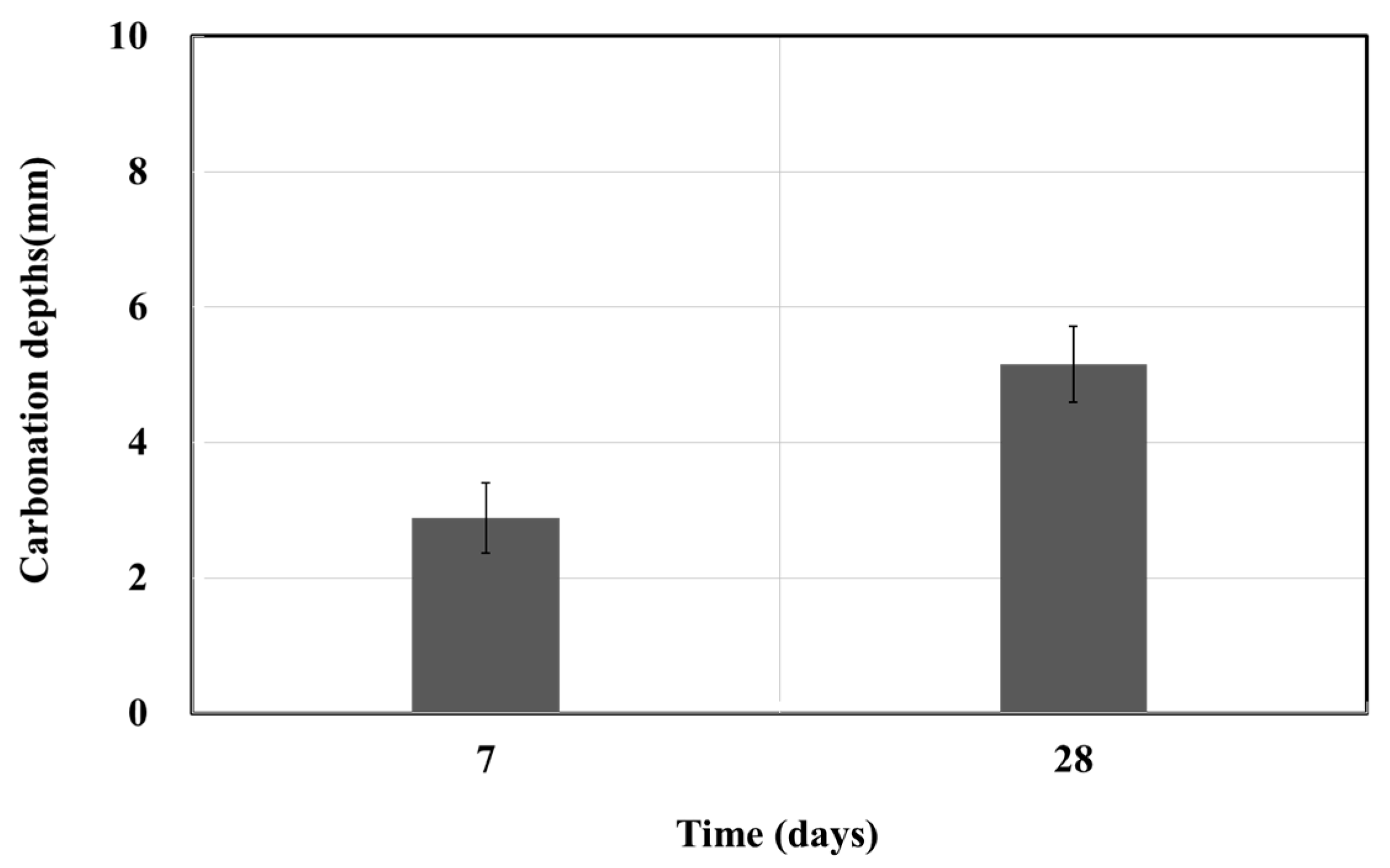
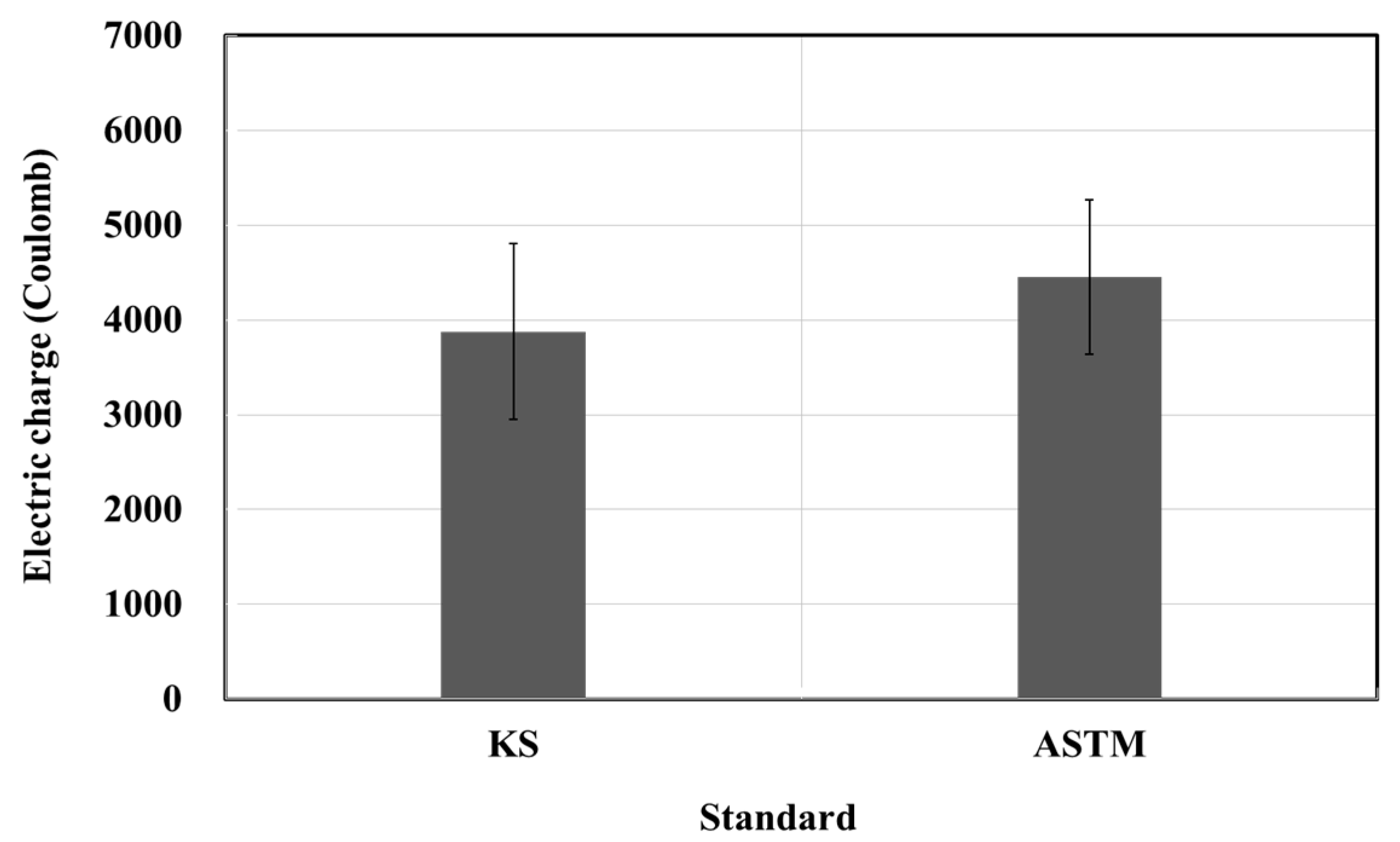
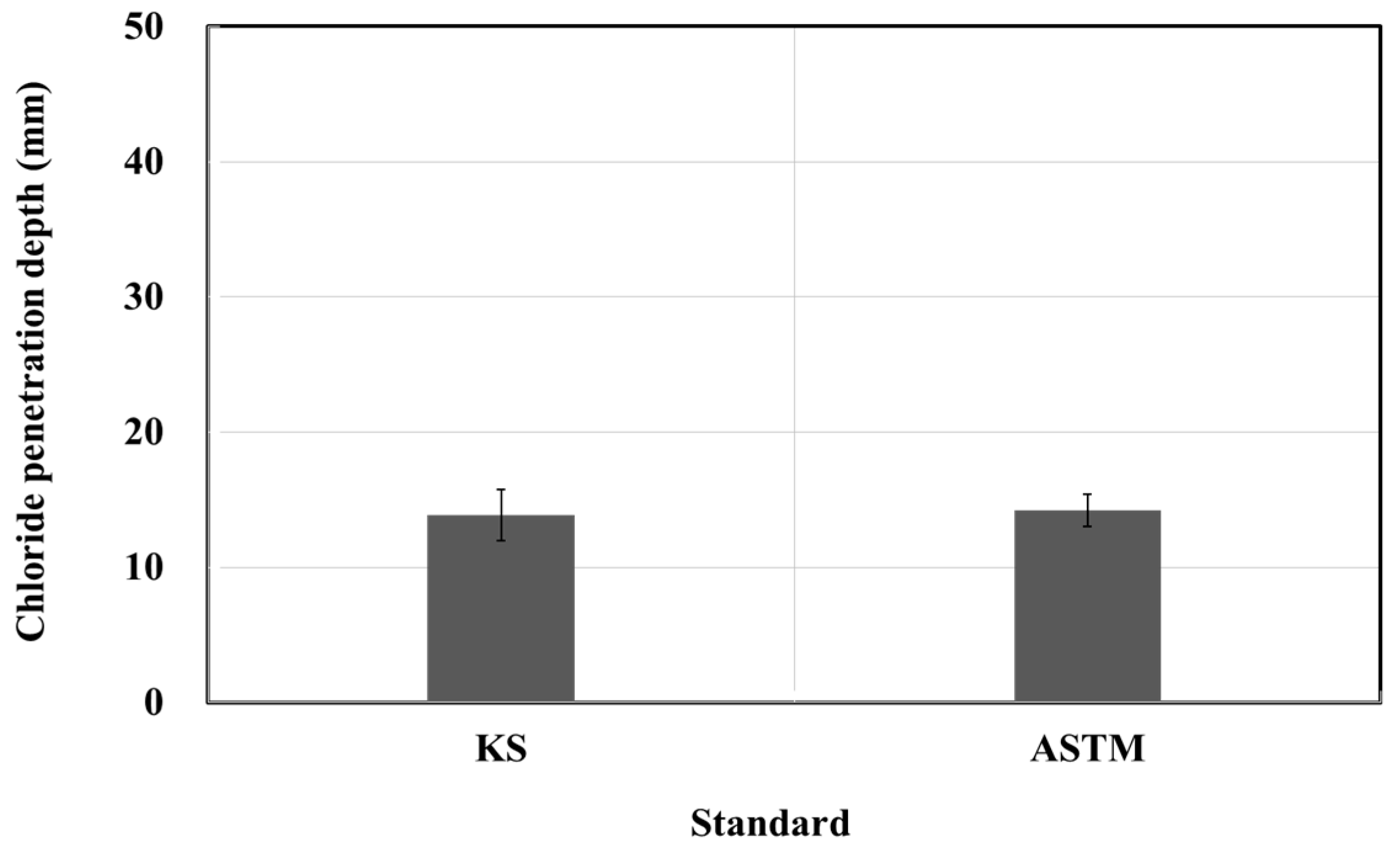
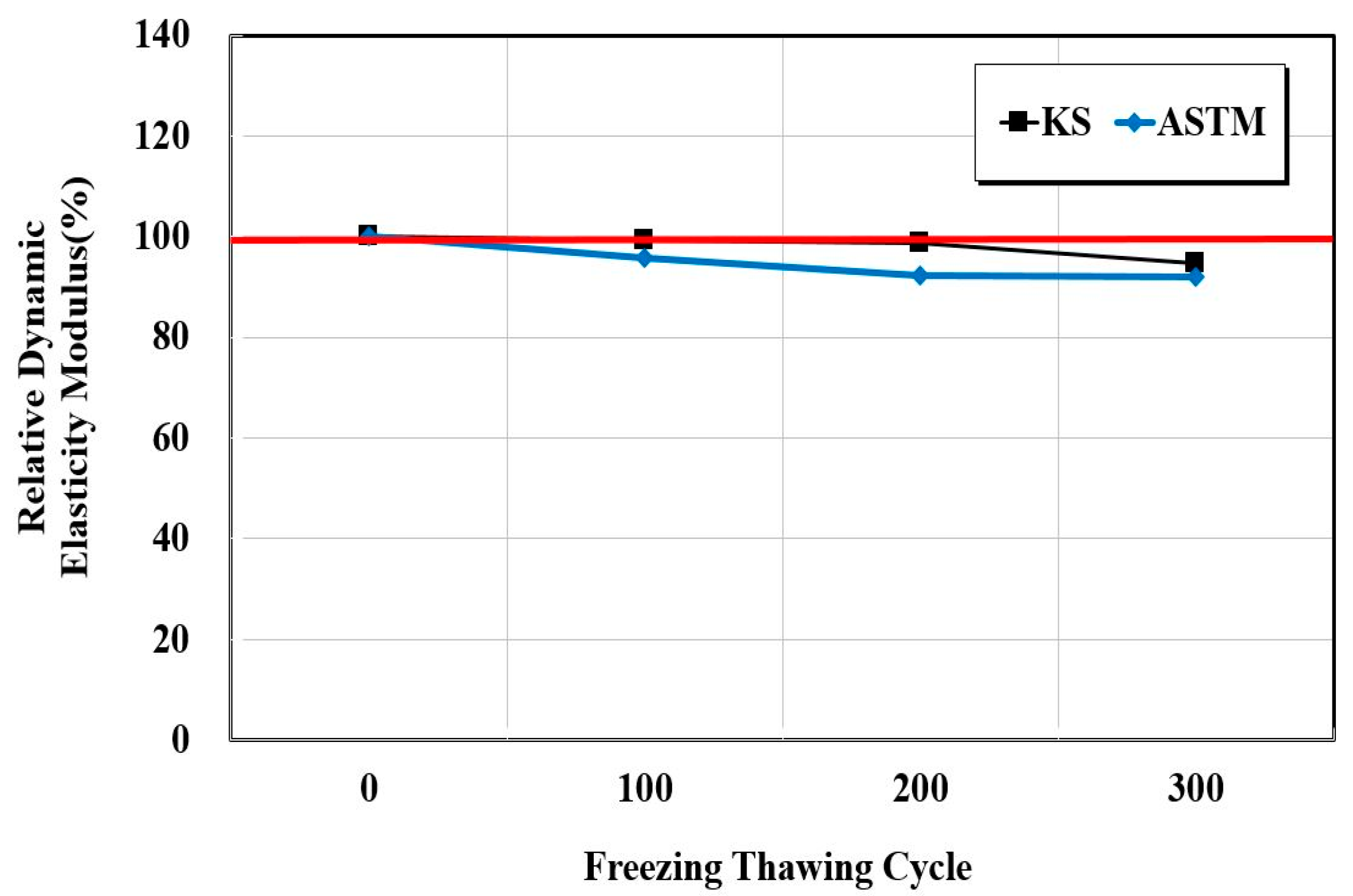
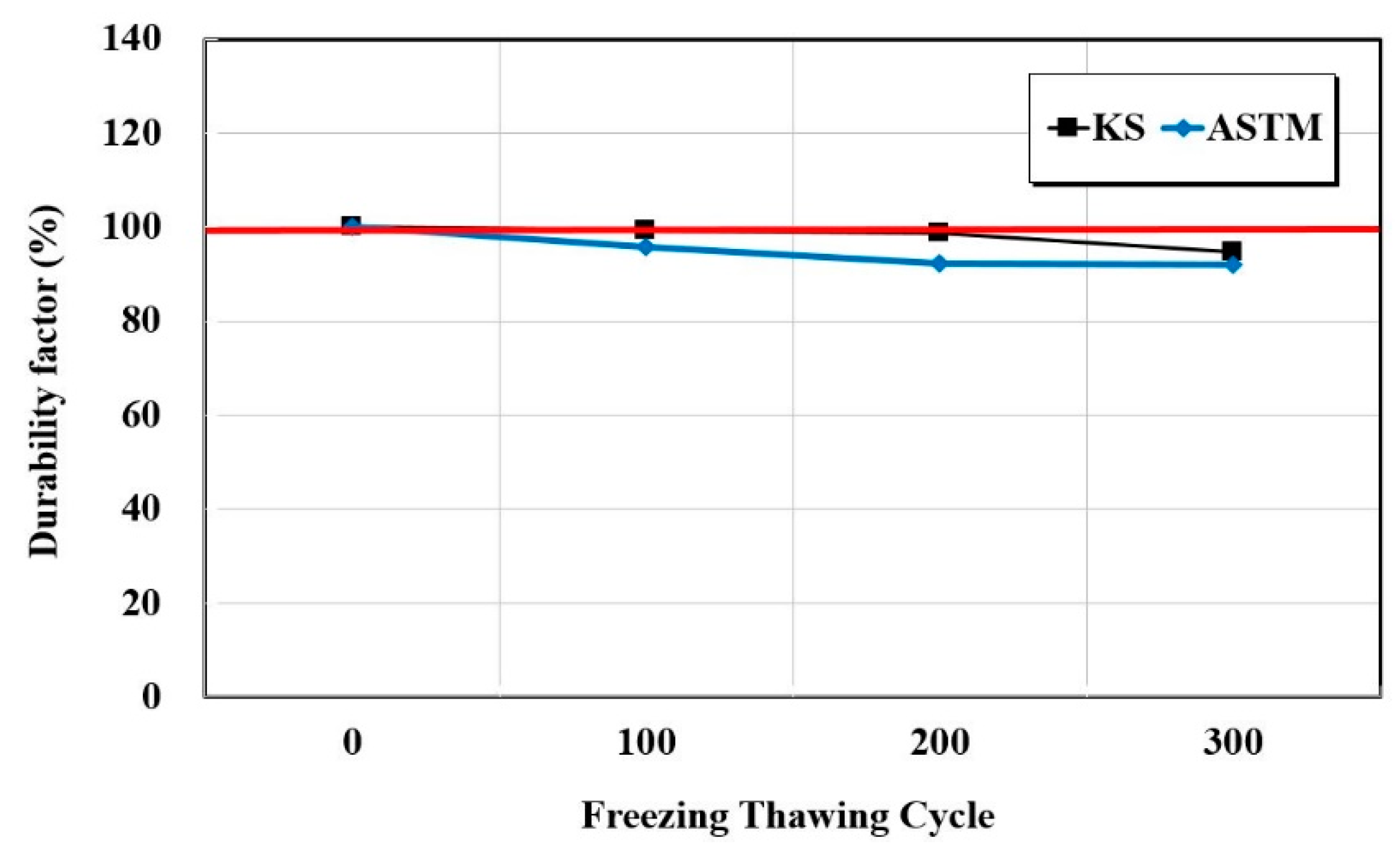

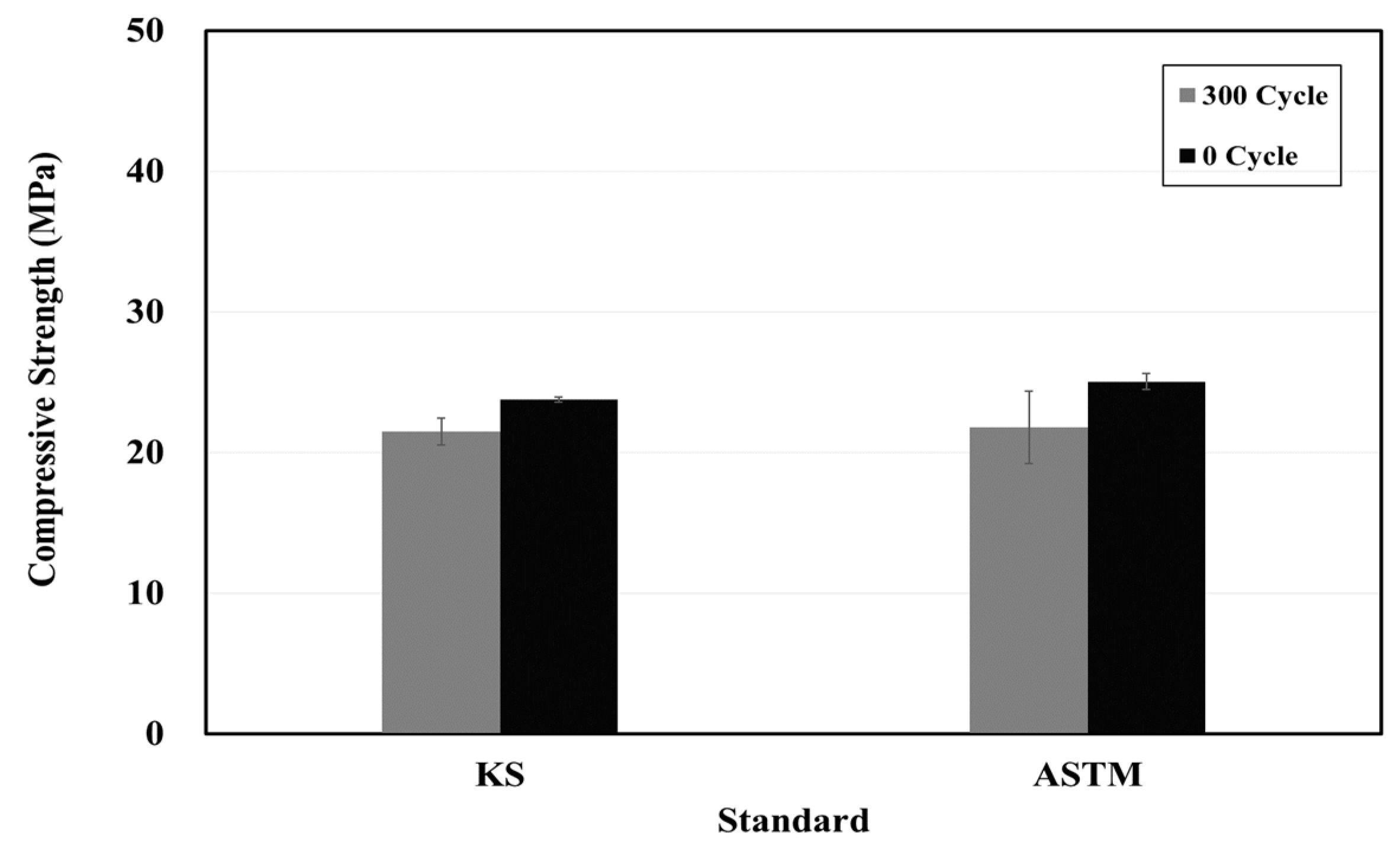
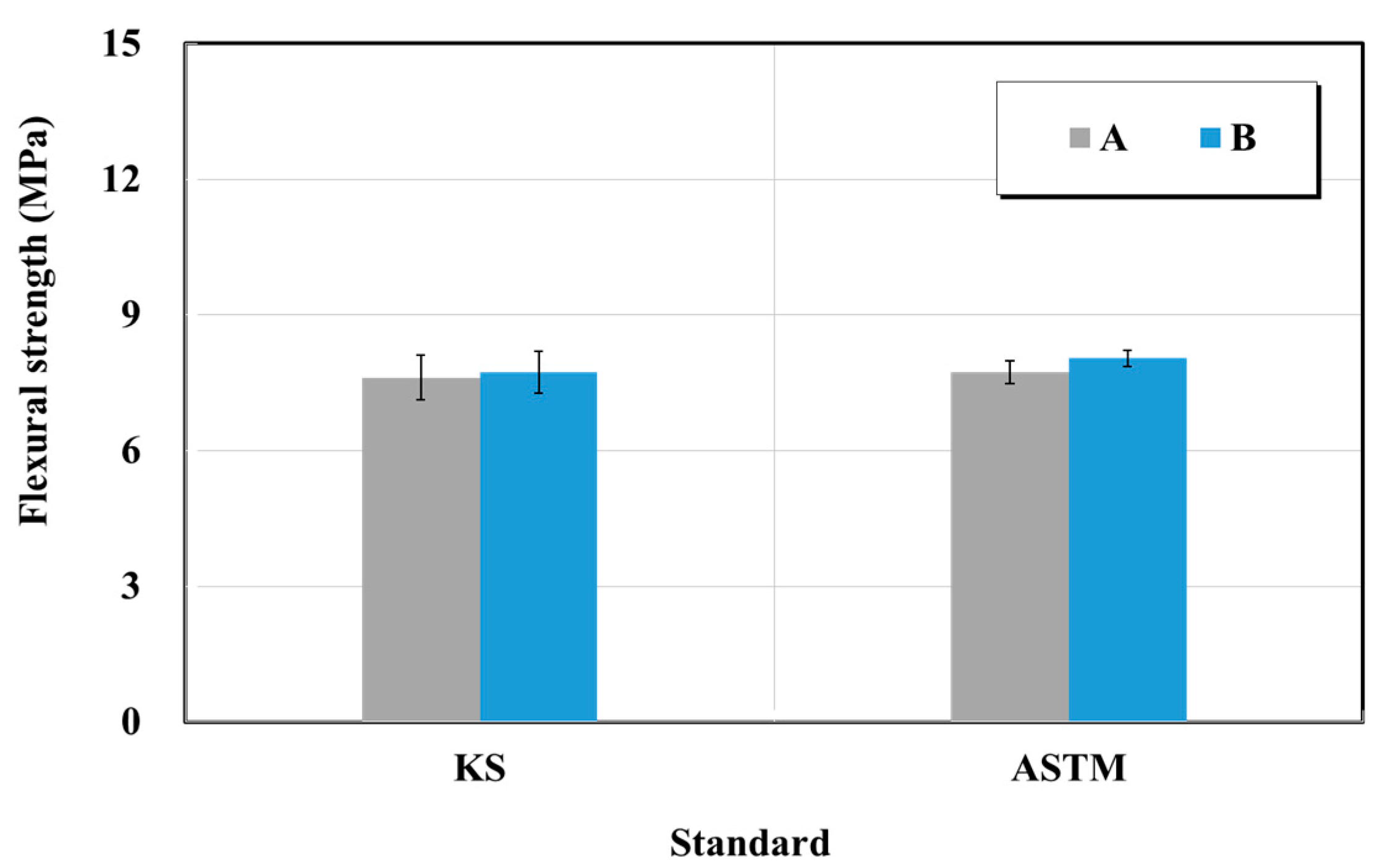
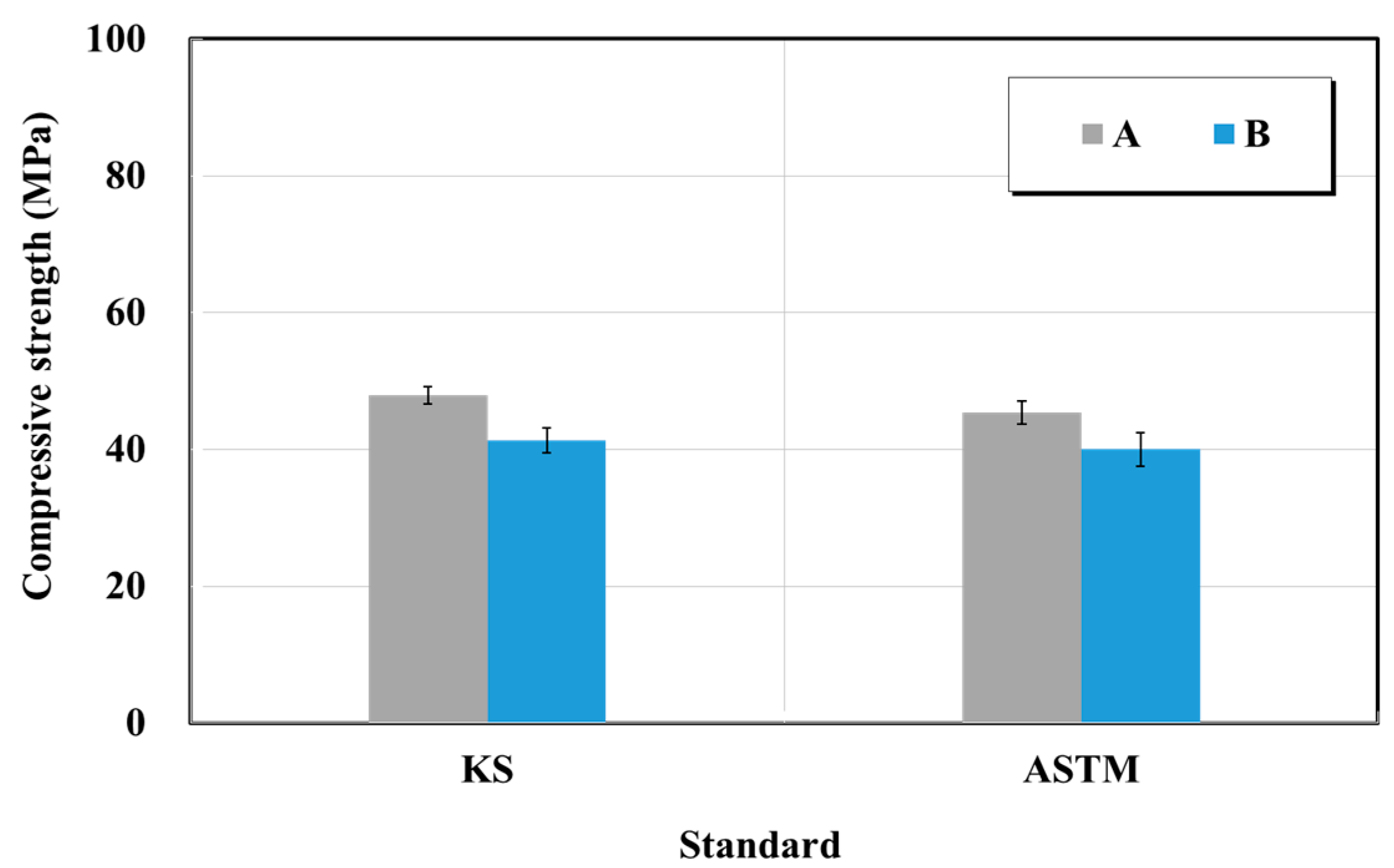
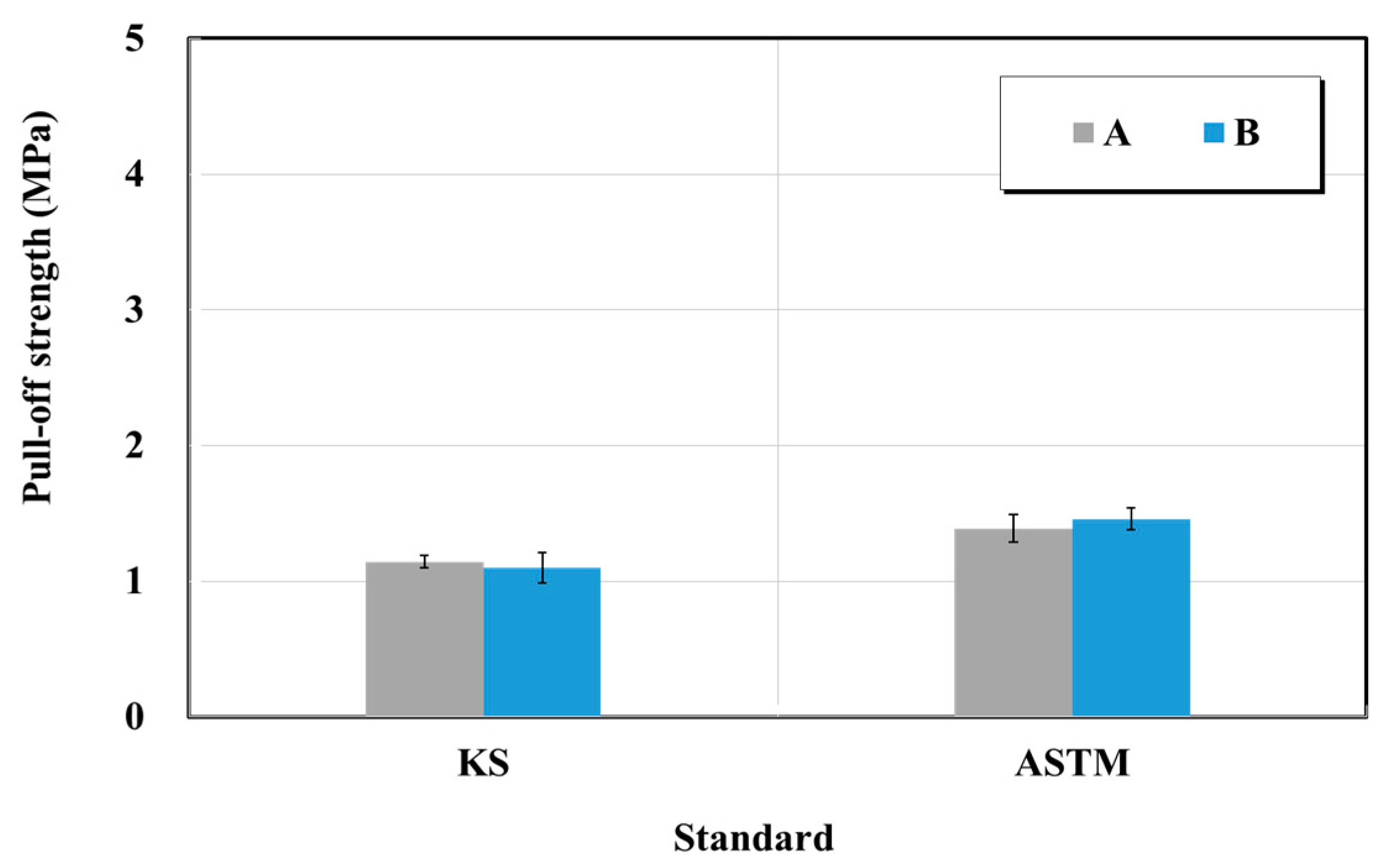
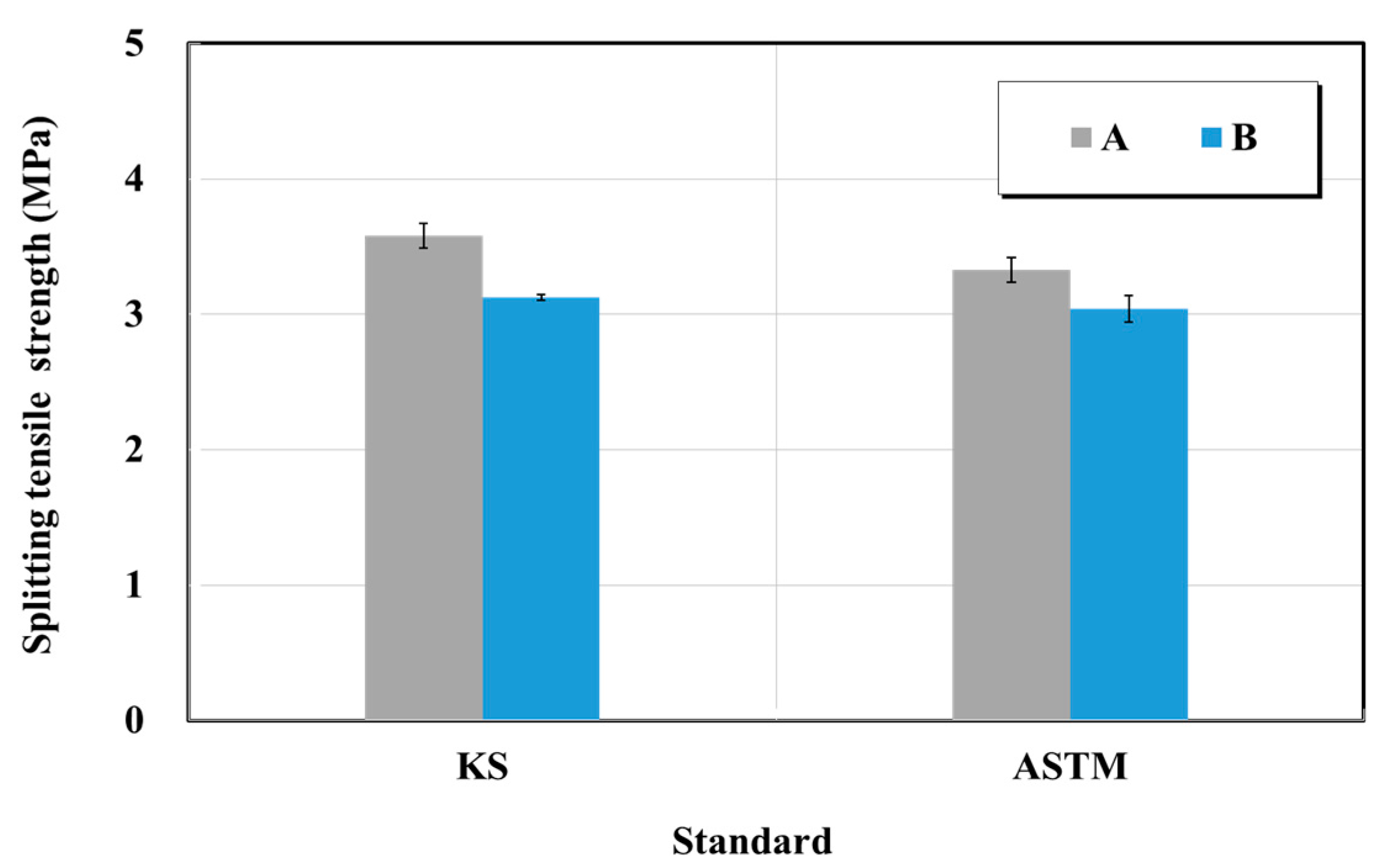
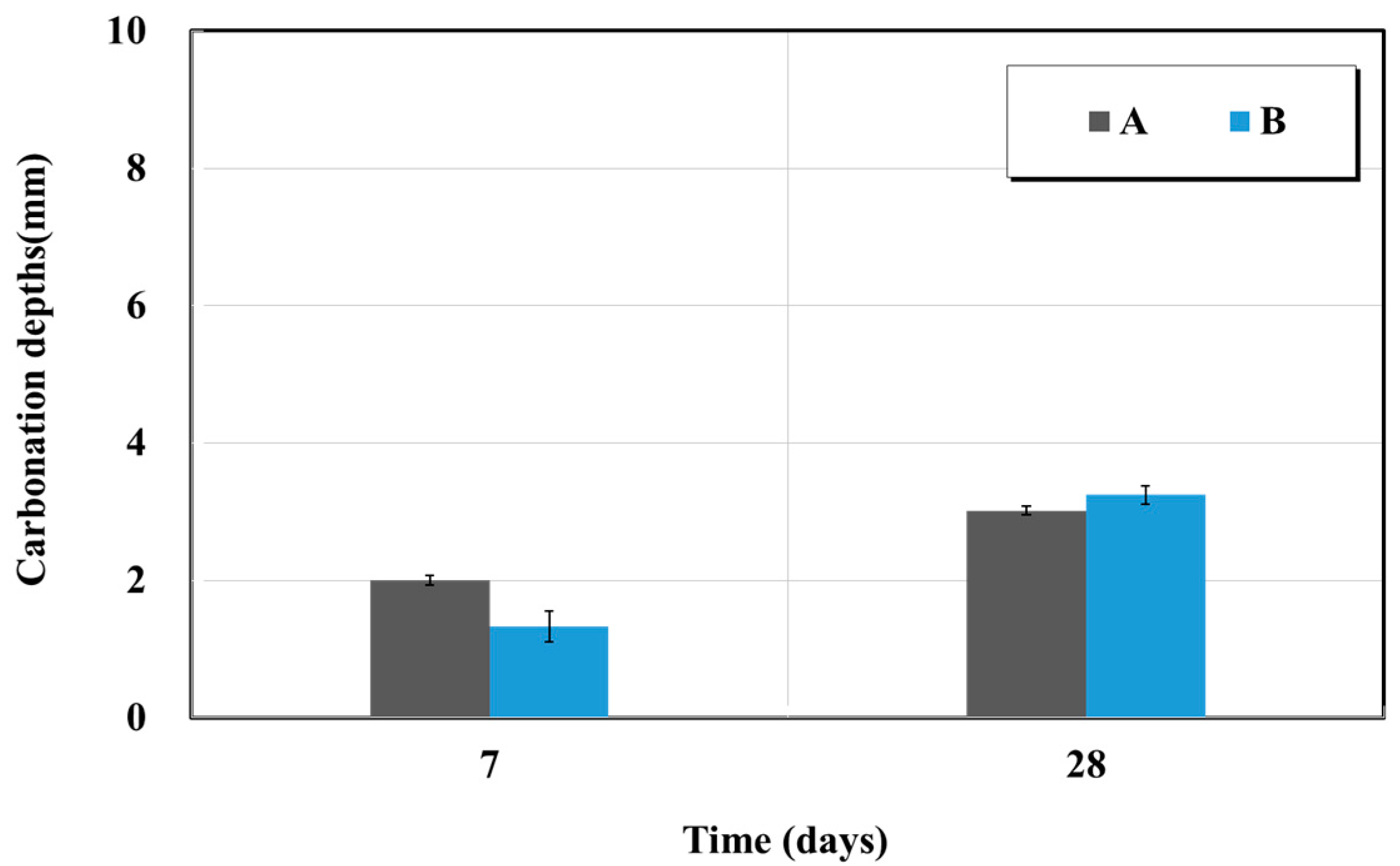
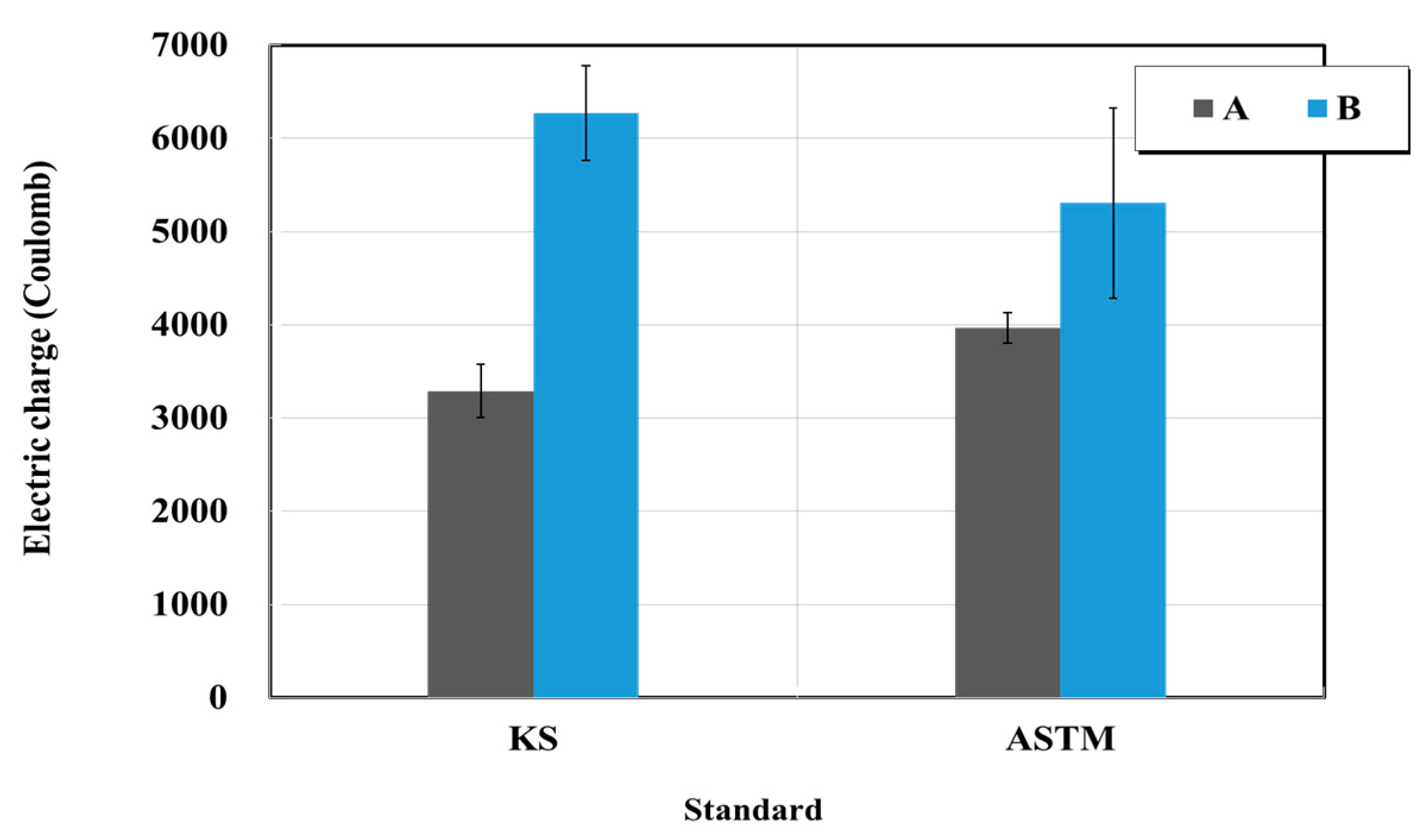

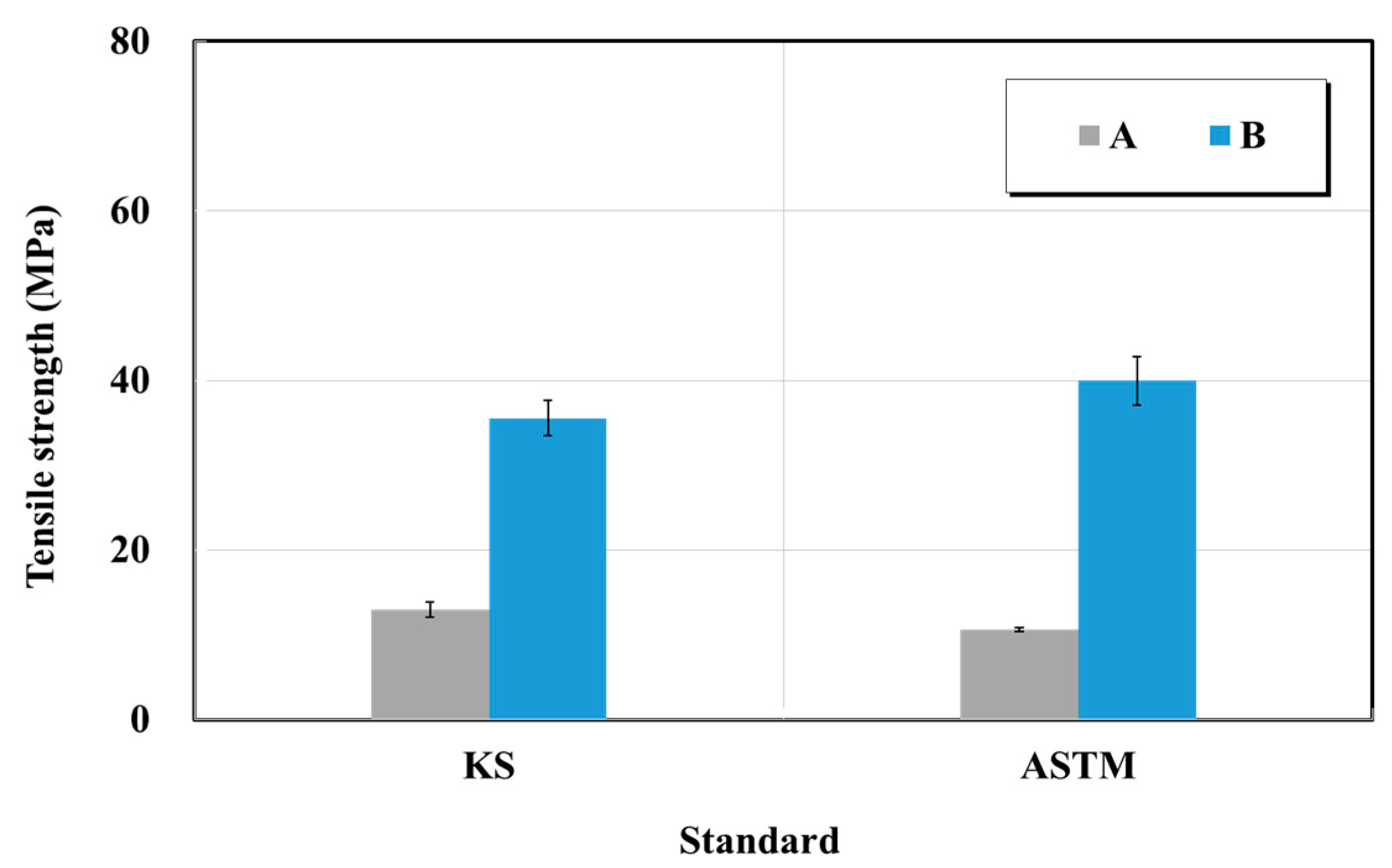
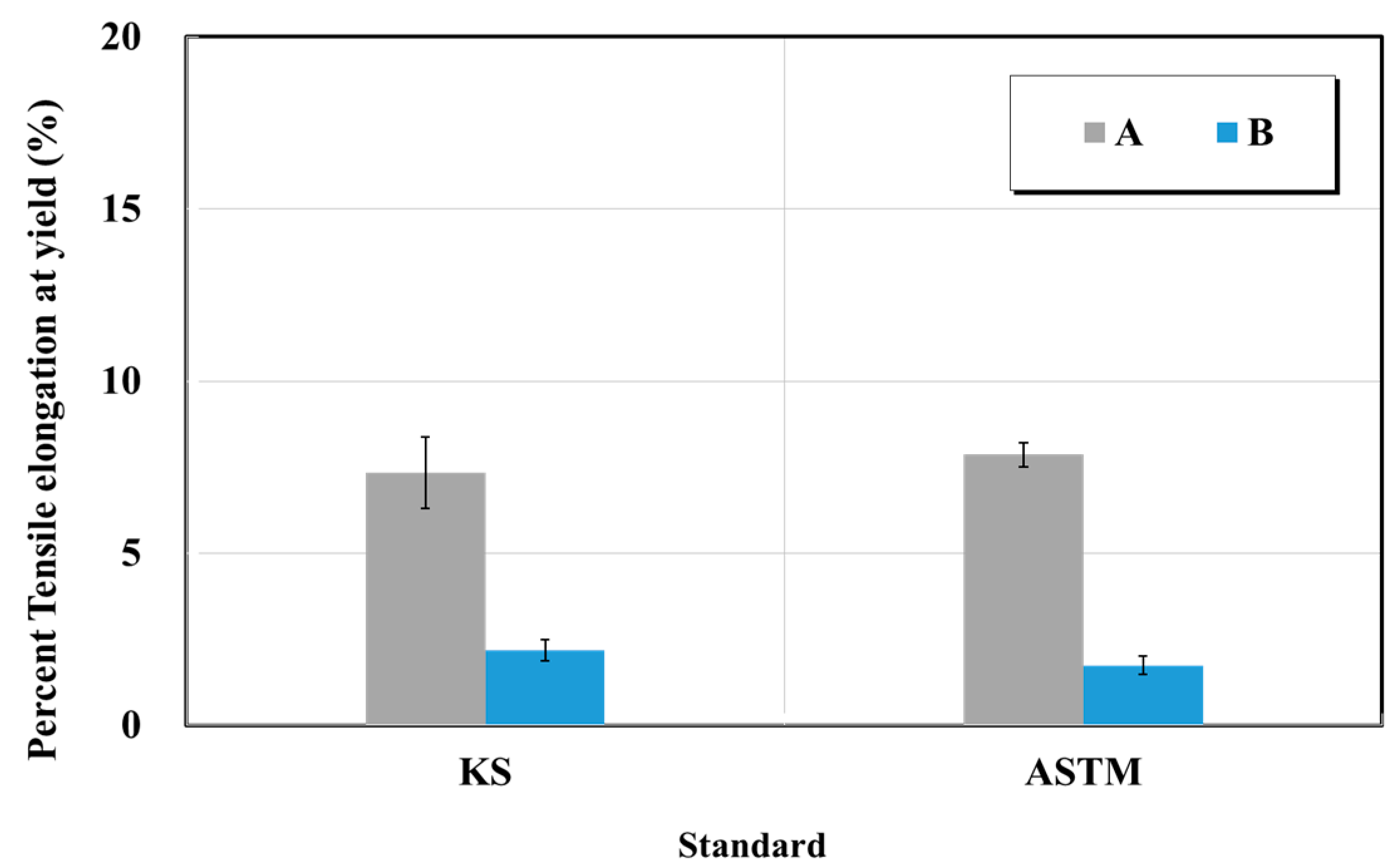
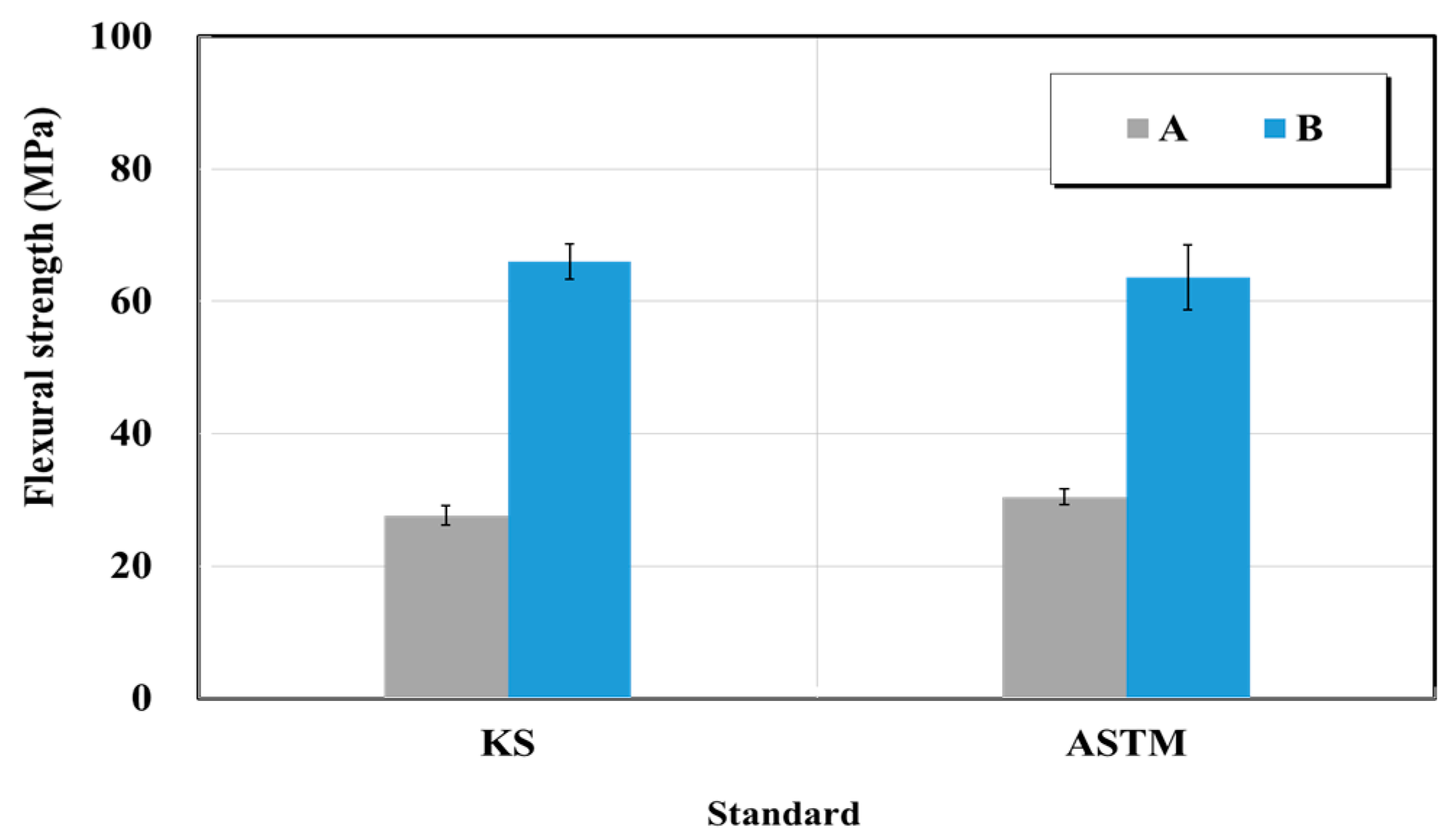
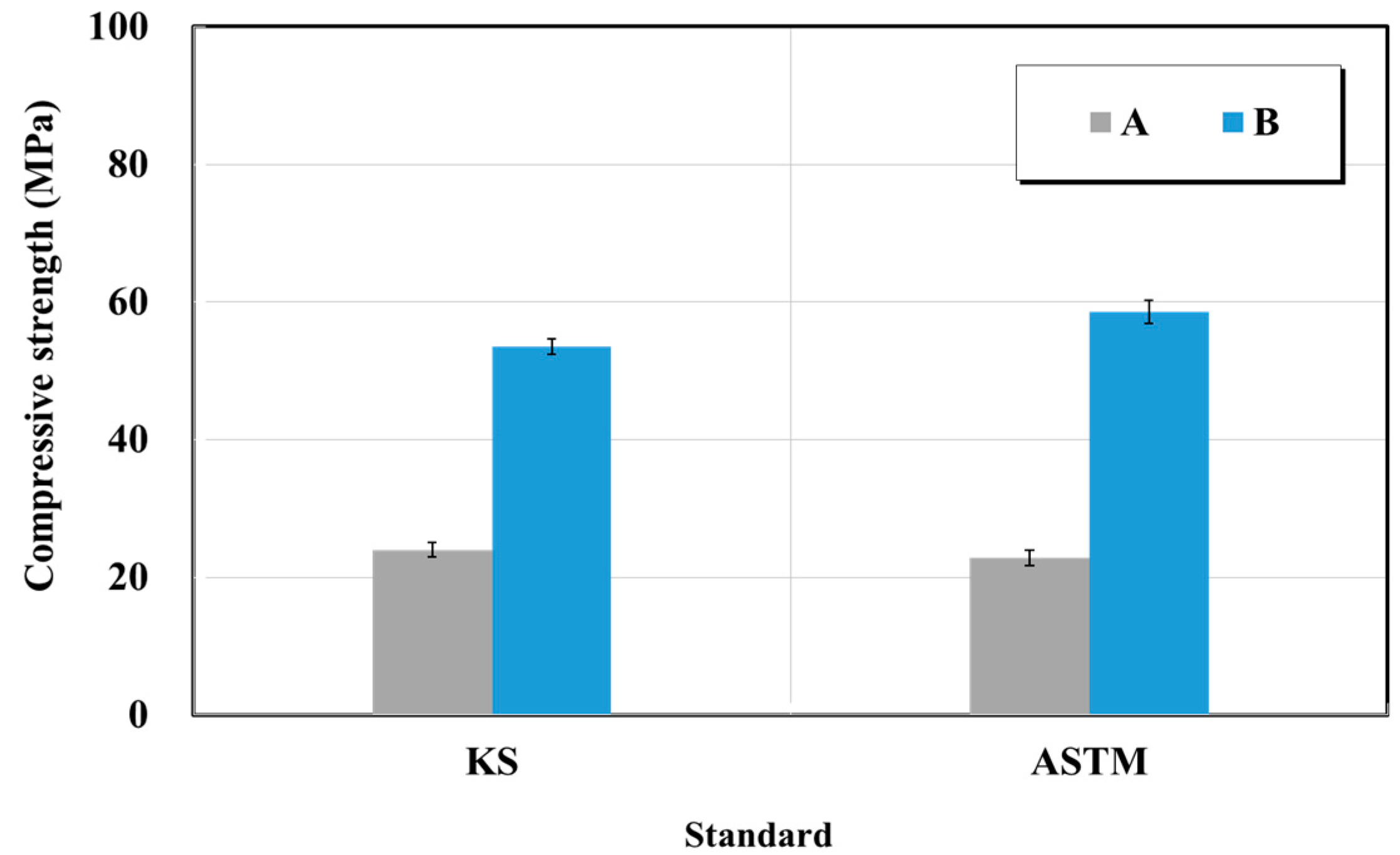

| Components | Advantages | Disadvantages |
|---|---|---|
| Epoxy resin | Good chemical resistance Good water resistance | Low-weather resistance Low variability Poor hardenability at low temperature |
| Vinyl ester resin | Corrosion resistance Good chemical resistance Good wear resistance | Short pot life Low maintainability depending on quality |
| Polyurethane | Good weather resistance High variability Fast drying response | Short pot life at high temperature Whitening when affected by moisture during curing |
| Fluororesin | Good weather resistance Quick drying | Short pot life at high temperature Whitening when affected by moisture during curing |
| Polyester resin | High-wear resistance | Short pot life |
| Tar epoxy resin | Water resistance Seawater resistance High-chemical resistance | Low-weather resistance Prone to whitening |
| Cement-based protection material | Good weather resistance Good durability | Prone to whitening |
| Components | Types of Structure Restoration Materials (Repair Mortar) |
|---|---|
| Polymer cement mortar | Polymer cement mortars such as SBR-, EVE-, and PAE-based (including rust inhibitor addition-based). The use of pre-combined products containing re-emulsifying powder resin is increasing |
| Polymer mortar | Polymer mortars (resin mortars), such as polyester resin-based, epoxy resin-based, acrylic resin-based (there are many products using lightweight aggregates) |
| Cement mortar or concrete | Ordinary cement mortar or concrete mixed with cement, such as ordinary Portland cement, high-early strength Portland cement, and rapidly set cement, aggregates, and chemical admixture for concrete |
| Components | Types of Crack-Repair Materials (Injection Materials) |
|---|---|
| Resin-based | Epoxy resin for injection, flexible epoxy resin for injection, polymer mortar, etc. |
| Cement-based | Polymer cement paste (slurry), expanded cement injection material, etc. |
| Sealant | Silicon-based, urethane-based, polysulphide-based, etc. |
| Classification | Test Type | Test Standards | Test Method |
|---|---|---|---|
| Structure protection material | Accelerated carbonation | KS F 2584 [15] | Standard test method for accelerated carbonation of concrete perform tests using concrete test standards by fabricating ∅100 × 200 specimens |
| KS F 2596 [16] | Method for measuring the carbonation depth of concrete | ||
| Resistance to chloride ion penetration | KS F 2711 [17] | Standard test method for resistance of concrete to chloride ion penetration based on electrical conductance Perform tests using concrete test standards by fabricating ∅100 × 50 specimens | |
| American Society for Testing and Materials (ASTM) C 1202 [18] | Standard test method for electrical indication of concrete’s ability to resist chloride ion penetration Perform tests using concrete test standards by fabricating ∅100 × 50 specimens | ||
| Resistance to freezing and thawing | KS F 2456 [19] | Standard test method for resistance of concrete to rapid freezing and thawing Perform tests using concrete test standards by fabricating ∅100 × 200 specimens | |
| ASTM C 666 [20] | Standard test method for resistance of concrete to rapid freezing and thawing Perform tests using concrete test standards by fabricating ∅100 × 200 specimens |
| Classification | Test Type | Test Standards | Test Method |
|---|---|---|---|
| Structure restoration material | Flexural strength | KS F 4042 [21] | Polymer modified cement mortar for maintenance in concrete structure—flexural strength test |
| ASTM C 348 [22] | Standard test method for flexural strength of hydraulic–cement mortars | ||
| Compressive strength | KS F 4042 [21] | Polymer modified cement mortar for maintenance in concrete structure—flexural strength test | |
| ASTM C 39 [23] | Standard test method for compressive strength of cylindrical concrete specimens | ||
| Bond strength | KS F 4042 [21] | Polymer modified cement mortar for maintenance in concrete structure—bond strength test | |
| ASTM C 1404 [24] | Standard test method used for bond strength of adhesive systems with concrete measured by direct tension | ||
| Resistance to chloride ion penetration | KS F 2711 [17] | Standard test method for resistance of concrete to chloride ion penetration based on electrical conductance | |
| ASTM C 1202 [18] | Standard test method for electrical indication of concrete’s ability to resist chloride ion penetration | ||
| Splitting tensile strength | KS F 2423 [25] | Standard test method for splitting tensile strength of concrete | |
| ASTM C 496 [26] | Standard test method for splitting tensile strength of cylindrical concrete specimens |
| Classification | Test Type | Test Standards | Test Method |
|---|---|---|---|
| Crack injection material | Bond strength | KS F 4923 [27] | Epoxy adhesives for repairing in concrete structure—bond strength |
| ASTM C 882 [28] | Standard test method for bond strength of epoxy-resin systems used with concrete by slant shear | ||
| Tensile strength (elongation) | KS F 4923 [27] KS M ISO 527 [29] | Epoxy adhesives for repairing in concrete structure; tensile strength and elongation at tensile failure Plastics—determination of tensile properties—general principles (part 1), test conditions for molding and extrusion plastics | |
| KS M 3015 [30] | Testing methods for thermosetting plastics | ||
| ASTM D 638 [31] | Standard test method for tensile properties of plastics | ||
| Compressive strength | KS F 4923 [27] | Epoxy adhesives for repairing in concrete structure—compressive strength of rigid epoxy resin | |
| KS M ISO 844 [32] | Rigid cellular plastics—determination of compression properties | ||
| KS M 3015 [30] | Testing methods for thermosetting plastics | ||
| ASTM D 695 [33] | Standard test method for compressive properties of rigid plastics | ||
| Flexural strength | KS M 3015 [30] | Testing methods for thermosetting plastics | |
| ASTM D 790 [34] | Standard test methods for flexural properties of unreinforced and reinforced plastics and electrical insulating materials |
Publisher’s Note: MDPI stays neutral with regard to jurisdictional claims in published maps and institutional affiliations. |
© 2022 by the authors. Licensee MDPI, Basel, Switzerland. This article is an open access article distributed under the terms and conditions of the Creative Commons Attribution (CC BY) license (https://creativecommons.org/licenses/by/4.0/).
Share and Cite
Kim, T.-K.; Park, J.-S. Comparative Analysis of Domestic and International Test Guidelines for Various Concrete Repair Materials. Materials 2022, 15, 3267. https://doi.org/10.3390/ma15093267
Kim T-K, Park J-S. Comparative Analysis of Domestic and International Test Guidelines for Various Concrete Repair Materials. Materials. 2022; 15(9):3267. https://doi.org/10.3390/ma15093267
Chicago/Turabian StyleKim, Tae-Kyun, and Jong-Sup Park. 2022. "Comparative Analysis of Domestic and International Test Guidelines for Various Concrete Repair Materials" Materials 15, no. 9: 3267. https://doi.org/10.3390/ma15093267
APA StyleKim, T.-K., & Park, J.-S. (2022). Comparative Analysis of Domestic and International Test Guidelines for Various Concrete Repair Materials. Materials, 15(9), 3267. https://doi.org/10.3390/ma15093267






